What Does Google Know About You?
Ever paused for a second, amidst a busy workday, to ponder on this question? It’s like suddenly realizing there’s an audience to your private show. You’re not paranoid; many business owners just like you are grappling with the same thought.
Unsolicited ads popping up relevant to a recent search or conversation
The feeling of being watched, resulting in self-censorship
Potential misuse of personal or business information
Inability to keep personal preferences or interests private
A continuous influx of emails and promotions from unknown senders
Increased vulnerability to cyber threats
Mistrust in online platforms, impacting digital business operations
Time wasted in sifting through irrelevant ads and content
Loss of personal touch; becoming just another data point in the vast digital sea
Constant worry about where and how personal or business data might be used
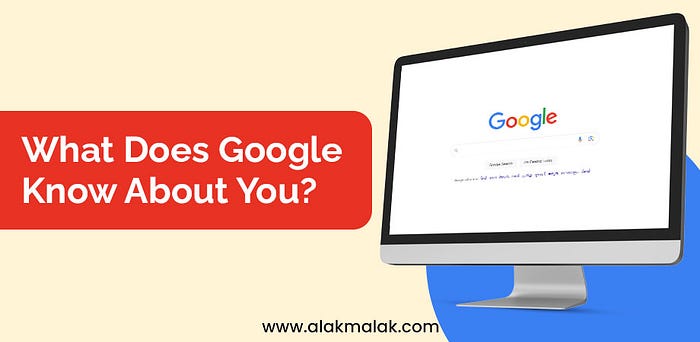
Contrary to popular belief, it’s not your numerous online searches that expose you. It’s deeper:
Cookie tracking beyond search engines
Use of Google tools and apps like Maps, Docs, or even Android OS
Engaging with websites or platforms integrated with Google services
Use of voice assistants that run on Google software
Having a Gmail account, where most of our personal and business correspondence happens
YouTube viewing preferences and searches
Google Calendar entries and schedules
Data collected from other users sharing information about you
Geo-locations from devices, showing not just where you are, but predicting where you’ll be
Did you know your Google Home might be listening more than you’d like?
Because those solutions fail to address the real cause. Or can even make the cause worse.
Private browsing or using an incognito window? They may not be as protective as you think. Regularly clearing your browser cache? Google has ways around it. Using non-Google apps? If they’re integrated with Google services, data can still be harvested. Relying solely on antivirus or firewalls? They don’t prevent data tracking.
What needs to be done to solve the issue
Understanding how data is collected is the first step, and a digital marketing expert knows its importance well. Educating oneself about what data is shared and when is crucial for individuals and businesses. It’s wise to avoid using a single account for personal and business matters to maintain data separation. Limit sharing unnecessary information, even if it seems harmless, to protect your privacy. A digital marketing expert also emphasizes the importance of frequently checking and updating your privacy settings. Staying informed about data breaches and what they mean for your data is key, and they may suggest opting for platforms that prioritize user privacy in their strategies and campaigns.
The Top 10 Benefits Of Implementing This New Solution
Enhanced personal and business privacy.
Freedom from unsolicited and often intrusive ads.
Increased confidence and trust in online operations.
Reduced vulnerability to potential cyber threats.
Saving time by not sifting through irrelevant ads.
Retaining personal touch and not just being another data statistic.
Assurance that private conversations remain private.
Streamlined, personalized content viewing on platforms like YouTube.
Sense of empowerment and control over personal and business data.
Peace of mind, knowing your data is safe.
A Complete Breakdown of Google’s New “My Activity” Dashboard
Have you ever wondered just how much Google knows about you? You might have had a hint each time a strangely accurate ad pops up or when a video recommendation feels eerily specific. But there’s a lot more to it than just Google Ads and videos. And Google has brought all of it to light with its new “My Activity” dashboard.
Why Should You Care?
Imagine an archive, a vast library of almost everything you’ve done online. That’s the “My Activity” dashboard for you. It’s where Google shows its cards, letting you see what data it’s collected about you. Remember that video on how to make macarons you watched three months ago? Yep, it’s there. That search about ‘how to manage sleep schedules’? That’s recorded too.
What’s On The Dashboard?
The dashboard is essentially a timeline of your online antics. From YouTube video views, searches, and visited websites, to interactions with Assistant and even places you’ve been to (thanks to Google Maps), it’s all there. Here’s what you’ll find:
Searches: Every time you use Google to search for anything, from academic research to search engine optimization techniques, random curiosities, or finding a new restaurant nearby, Google remembers
YouTube: Those cat videos or DIY crafts you’ve watched? They’re on the list. The dashboard even records the videos you’ve merely clicked on.
Ads: The dashboard reflects the ads you’ve interacted with, giving you a hint as to why you are being targeted with specific content.
Websites: Using Google Chrome means your browsing history is on the dashboard too.
Location: If you have location history turned on, the dashboard will display places you’ve visited, routes you’ve taken, and even how long you stayed.
Is It All Bad?
Not necessarily. The dashboard isn’t there to spook you. Instead, Google offers this level of transparency to give users a semblance of control. With the dashboard:
Personalization: Google uses this data to refine its services for you. The more it knows, the better its algorithms can personalize your online experience. This means better search results, more relevant ads, and YouTube content tailored just for you.
Control: With great data, comes great responsibility. Google understands this. That’s why the dashboard isn’t just a view-only portal. You can delete data points, or even erase your entire activity history if you wish.
What Can You Do?
Feeling uneasy? That’s okay. As mentioned earlier, Google offers control. Within the dashboard:
Delete Data: You can select specific data points and delete them. So, if there’s a particular search or site you’d rather Google forgot about, you can erase it.
Filter By Date or Service: If you wish to review your activity for a specific period or from a particular Google service (like YouTube), you can do that.
Turn Off Tracking: Google also lets you stop the data recording altogether. There’s an option to pause specific tracking features, meaning Google will no longer store that data.
In a digital era where data is the new oil, transparency, and control are crucial. While Google’s “My Activity” dashboard might initially seem like a daunting reminder of our digital footprints, it’s also a tool of empowerment. It’s a space where you can revisit your online journey, tweak its direction, and even choose to wander off the grid if you wish.
Navigation and Layout
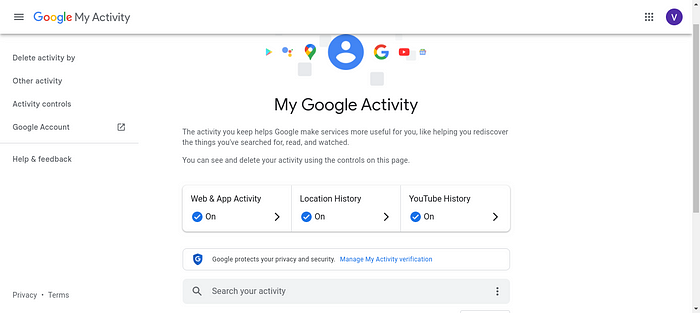
It’s user-friendly. All activities are categorized based on Google services, making it easy to review.
“Delete Activity By” Feature in Google’s “My Activity” Dashboard
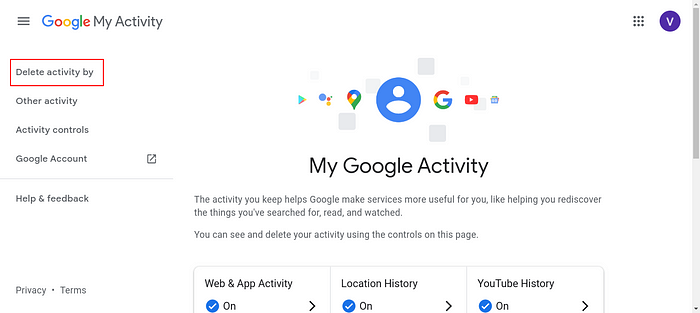
Privacy concerns and the right to data ownership have become significant points of discussion in the digital age. Google, being a leading tech giant, understands the importance of granting users more control over their data. One such empowerment tool is the “Delete Activity By” feature in the “My Activity” dashboard. Let’s delve into the intricacies and significance of this feature.
Choosing the Data You Wish to Erase
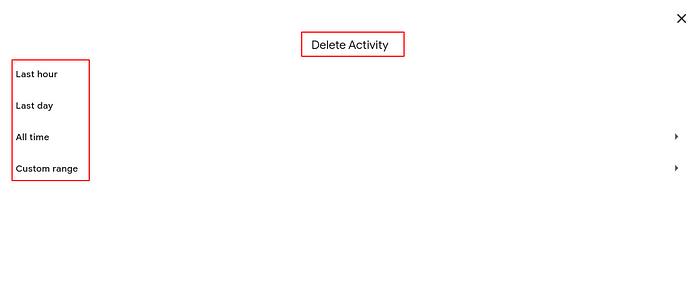
One of the primary functions of the “Delete Activity By” option is its specificity. Unlike a blanket delete command that might remove everything, this feature provides granular control, allowing users to:
Select Specific Dates: Maybe you had a day of unusual searches you’d rather forget, or perhaps there’s a particular period you’d like to remove from your digital footprint. By choosing a specific date or date range, you can ensure those activities are erased while leaving the rest untouched.
Opt for Specific Google Services: If you want to erase your YouTube watch history but leave your Google Search activity intact, this is the feature for you. You can select a particular Google service, ensuring only data from that platform is deleted.
The Process: Simple and Straightforward
Google has designed this feature with user-friendliness in mind. Here’s how the process typically unfolds:
Access “My Activity” Dashboard: Navigate to the dashboard and look for the “Delete Activity By” option, usually prominently displayed.
Specify Your Criteria: Whether you’re going by date or service, use the dropdown menus or calendars to narrow down your deletion criteria.
Review and Delete: Before the final deletion, Google typically offers a brief summary of what you’re about to remove, ensuring you’re making an informed choice. Once confirmed, the specified data is erased from your account.
Why This Feature Matters
The “Delete Activity By” feature isn’t just about erasing past searches or activities; it’s a step towards more extensive digital rights. Here’s why:
Enhanced Privacy: By allowing users to selectively delete their data, Google is offering an additional layer of privacy. Users can ensure that sensitive or personal searches don’t remain stored indefinitely.
Taking Control of One’s Digital Footprint: Our online activities tell a story about us. By giving users the power to curate this story, Google is promoting responsible and conscious internet usage.
Trust Building: Features like these enhance the trust relationship between platforms like Google and their users. Knowing that a platform respects user autonomy when it comes to data can boost confidence and loyalty.
“Other Google Activity” in the “My Activity” Dashboard
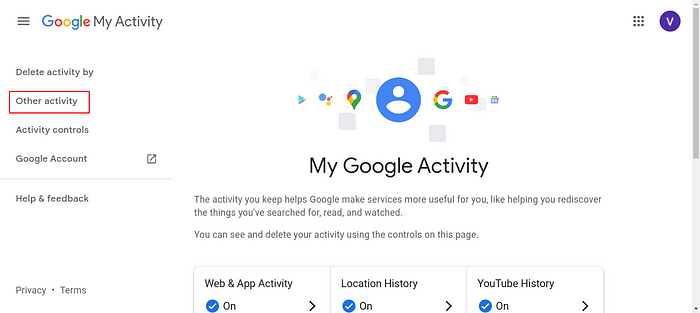
The digital footprint you leave on Google isn’t just about the search queries you type or the YouTube videos you watch. There’s a myriad of other interactions and data points that Google collects, and all these are neatly compiled under the “Other Google Activity” section in the “My Activity” dashboard. Let’s dive deeper into understanding this aspect of our digital interaction with Google.
Beyond Just Searches: A Multifaceted Interaction
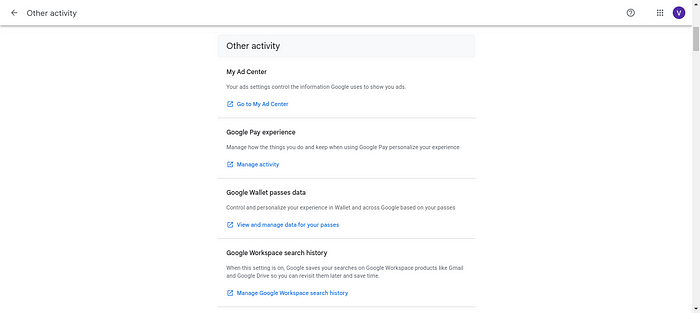
The term “Other Google Activity” might sound nebulous, but it essentially encompasses all the additional ways you engage with Google services outside of direct searches. Here’s a breakdown of what it usually includes:
Location History: If you use Google Maps or have location services turned on, Google tracks your movement. This data aids in offering better location-based suggestions and more accurate traffic predictions.
Device Information: Google might log details about the devices you use to access its services. This could include data like device type, operating system, and even hardware stats, ensuring smoother service delivery tailored to your device’s capabilities.
Voice and Audio Activity: For those who use voice commands or Google Assistant, Google might store voice snippets to improve voice recognition and provide a more personalized user experience.
App Activity: If you use Google Play or other Google apps, your app activity, like the apps you install, use, or uninstall, can be listed under this section.
Navigating the “Other Google Activity” Section
Accessing and understanding this data is straightforward:
Log into the “My Activity” Dashboard: Once there, look for the “Other Google Activity” tab.
Browse Through the Listings: Each type of activity has its section, making it easier to navigate and understand the kind of data stored.
Manage and Delete if Necessary: Like other sections in the dashboard, users retain the autonomy to review and, if needed, delete specific data points.
The Importance of Recognizing “Other Google Activity”
Knowing about this additional layer of data collection is crucial for several reasons:
Holistic Understanding of Data Collection: Being aware of the full spectrum of data Google collects ensures users understand the depth and breadth of their digital interactions.
Informed Decision Making: When users know what data is being stored, they can make informed choices about their privacy settings and how they interact with Google services.
Enhanced User Experience: Many of these data collections, while they might seem intrusive, are geared towards tailoring a more personalized and efficient user experience.
“Activity Controls” in the “My Activity” Dashboard (How to Stop Google from Collecting Your Information)
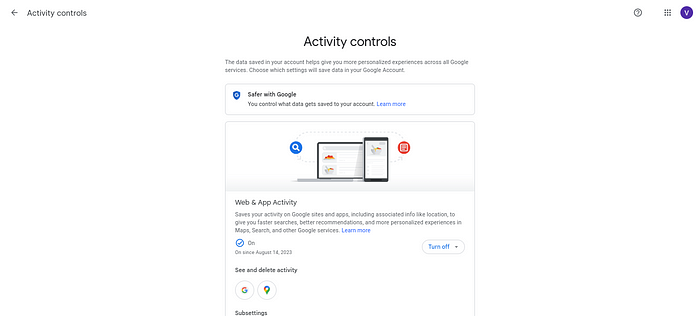
In the digital age, privacy is a currency. And while many of us enjoy the convenience Google services provide, it’s essential to have control over the type of information Google collects about us. That’s where “Activity Controls” come into play. Located within the “My Activity” dashboard, these controls are designed to give users agency over their data. Here’s a deep dive into these controls and how they can be your digital safeguard.
Decoding the “Activity Controls”
“Activity Controls” is essentially a toolkit that lets you decide what data Google can collect and use across its services. These are the features it usually encompasses:
Web & App Activity: This controls whether Google can track and store your searches, pages you visit, and other activities on Google apps and services. By toggling this off, Google stops saving these data points.
Location History: If you’re wary about Google knowing your every move, this control lets you halt the collection of your location data.
Voice & Audio Activity: For those concerned about Google storing voice commands or conversations with Google Assistant, this control can put an end to such recordings.
YouTube Search & Watch History: Prefer to keep your video preferences private? These controls allow users to stop Google from saving their search and viewing history on YouTube.
Device Information: This control can halt Google from storing information about your devices, such as contacts, calendars, and apps.
How to Harness the Power of “Activity Controls”
Navigating and setting up these controls is quite user-friendly:
Access “My Activity” Dashboard: Once logged in, find the “Activity Controls” section.
Toggle On/Off as Needed: Each type of activity will have a toggle switch. Simply click on it to turn off data collection for that specific activity.
Review & Confirm: Before finalizing your choices, it’s always good to review and ensure you’ve set the controls as per your comfort level.
The Significance of “Activity Controls”
The existence and ease of use of these controls highlight several critical points:
User Autonomy: Google recognizes the significance of user autonomy in data privacy, ensuring individuals have the final say on their data.
Balancing Convenience with Privacy: While collecting data helps Google enhance its user experience, it also offers users a way to balance this convenience with their privacy concerns.
Transparency: By laying out all data collection methods transparently and giving users an easy way to control them, Google emphasizes its commitment to responsible data usage.
Deleting Your Entire Google Account: The Nuclear Option
The modern digital age means many of us are intertwined with services offered by tech giants like Google. Whether it’s for professional use, personal entertainment, or a mix of both, Google’s suite of services have become almost second nature to many. However, there are occasions when users may decide to delete their Google Account entirely. Before taking this drastic step, it’s vital to understand the full implications.
What Does “Deleting Your Google Account” Mean?
Deleting your Google account isn’t just about removing a Gmail address. It’s about erasing your digital footprint across all Google services. Here’s what that entails:
Gmail: All emails, drafts, and attachments will be permanently deleted.
Google Drive: Every document, photo, video, and file stored will vanish.
YouTube: Say goodbye to your uploaded videos, comments, likes, and subscriptions.
Google Photos: All your photos and videos will be removed.
Google Calendar: Any appointments, reminders, and shared calendars will be gone.
Google Play: Purchased apps, movies, games, and books will no longer be accessible.
Google Contacts: The contacts stored in your Google account will be deleted.
Search History & Data: Your search preferences and history across Google services will be wiped clean.
And much more: This includes other services like Google Maps’ saved places, Google Keep notes, etc.
The Process of Deletion
Backup: Before you even think of deleting your account, backup essential data. Google Takeout allows users to download their data across Google services.
Access Account Preferences: Go to Google’s account preferences.
Select ‘Delete your account or services‘: This section gives you the option to either delete specific Google services or your entire Google account.
Follow the Prompts: Google will guide you through the deletion process, ensuring you understand the ramifications of your decision.
Final Confirmation: You will be asked to enter your password and confirm that you genuinely want to delete your account. This step is irreversible.
Considerations Before Taking the Leap
Permanency: Remember, once deleted, the data cannot be recovered. It’s gone forever.
Associated Services: Many third-party services use Google for logins. Ensure you change login methods for these services before deleting your account.
Communication: Inform your contacts that your Gmail will no longer be operational.
Digital Purchases: You will lose access to any digital content purchased through Google platforms.
So… What Does Google Know About You?
In essence, quite a lot. More than some close friends might even know. But armed with the right knowledge and tools, you can determine how this narrative goes.
Conclusion:
In the digital age, our online footprints are vast and varied. Google, being at the forefront of internet services, has over time accrued a staggering amount of user data, intricately mapping our digital behaviors, preferences, and habits. From the websites we visit, and the videos we watch, to the places we frequent, Google has an almost encyclopedic knowledge of its users. This vast collection of data is not merely an idle archive; it drives the personalized experiences we receive, making services more efficient and advertisements more relevant.
However, with such immense power comes significant responsibility. As users, it’s crucial to be aware of the data we share, intentionally or otherwise, and the tools at our disposal to manage this data. Balancing the conveniences of personalization with the imperatives of privacy is the ongoing challenge of our times. In the end, the question isn’t just what Google knows about us, but how we choose to navigate and shape that knowledge in an era of digital omnipresence.
“Concerned about what Google knows about you? Reach out to us now, and let our team help you navigate and protect your digital footprint. Contact us today!”